
Top 5 AI Tools for Perishable Inventory
Managing perishable inventory is tough. Spoilage, unpredictable demand, and manual tracking can hurt profits and waste resources. AI tools solve these issues by automating tasks, predicting demand, and minimizing waste. Here's a quick look at the top 5 AI tools for perishable inventory management:
- Netstock: Predicts demand with AI, integrates with 200+ ERP systems, and prioritizes shelf-life management to reduce waste.
- Relex Solutions: Offers real-time tracking and predictive analytics for large retailers, optimizing supply chains to prevent spoilage.
- GMDH Streamline: Combines forecasting with easy integration, ideal for small to medium businesses.
- EazyStock: Focuses on accurate demand forecasting and inventory tracking to avoid overstocking and waste.
- SkuNexus: Tailored for eCommerce, it automates multi-warehouse operations and tracks time-sensitive goods.
Quick Comparison:
| Tool | Best For | Key Features | Integration Options |
|---|---|---|---|
| Netstock | Mid to large enterprises | Expiration tracking, AI forecasting | 200+ ERP systems, POS tools |
| Relex | Large retailers | Real-time visibility, freshness monitoring | Retail and supply chain platforms |
| GMDH Streamline | Small to medium businesses | Statistical forecasting, FIFO/FEFO rotation | SAP, QuickBooks, Odoo |
| EazyStock | Diverse product portfolios | Seasonal demand forecasting | SAP, Oracle, NetSuite |
| SkuNexus | eCommerce with multi-warehouse ops | Automated routing, real-time synchronization | Shopify, BigCommerce, Magento |
AI tools are transforming perishable inventory management by reducing waste, improving forecasting accuracy, and automating complex processes. Whether you're managing fresh produce, pharmaceuticals, or prepared foods, these solutions can help streamline your operations and boost efficiency.
1. Netstock
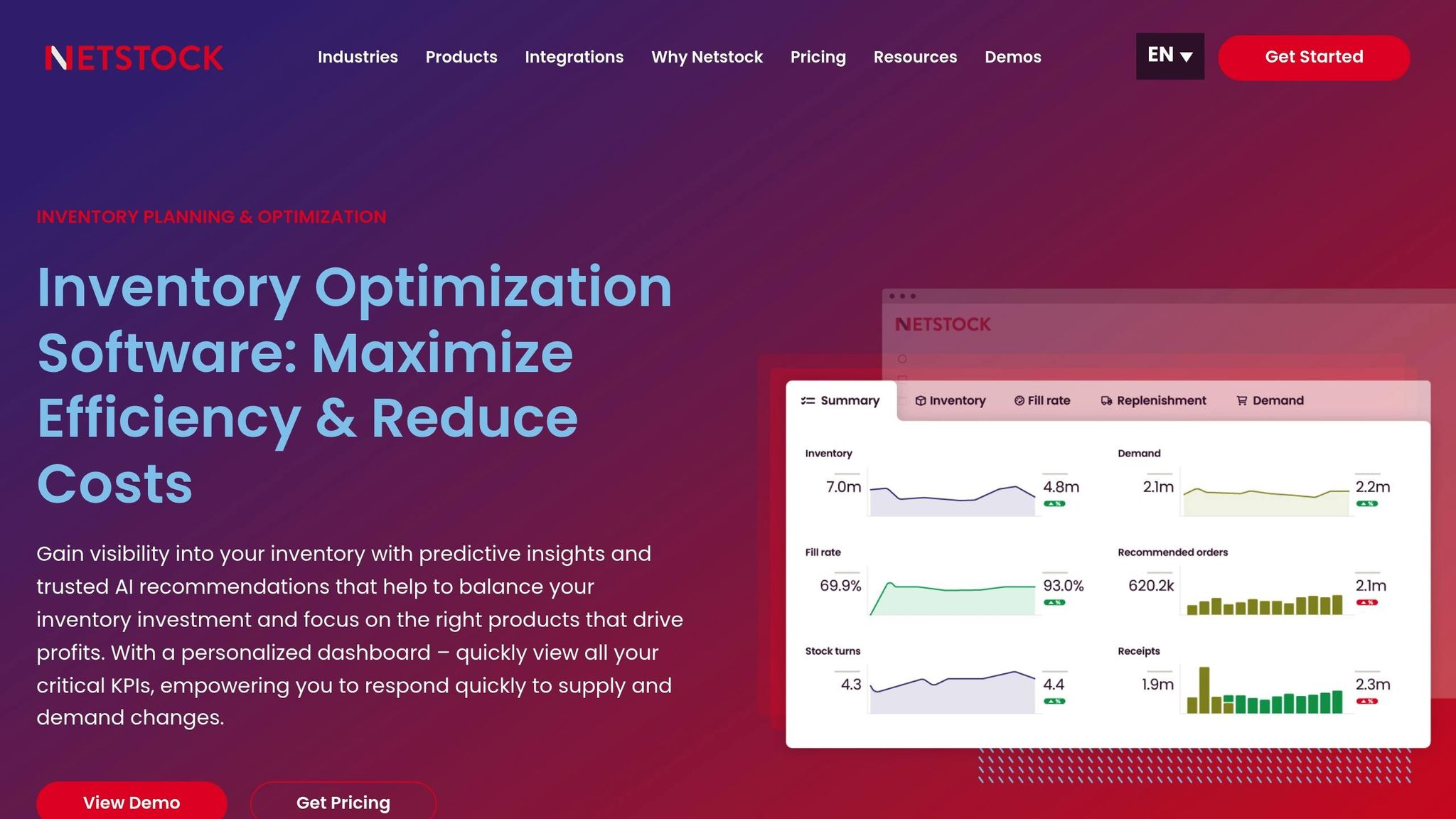
Netstock is an inventory optimization platform powered by AI, originally founded in South Africa. It has earned a solid reputation for helping businesses manage demand planning and inventory, especially in industries handling perishable goods.
Predictive Analytics
Netstock uses AI to dive deep into sales history, seasonal trends, and external factors, delivering highly accurate demand forecasts. This is particularly useful for perishable goods, where timing is critical.
Its machine learning capabilities uncover patterns that might go unnoticed by human analysis. For example, businesses dealing with fresh produce or dairy can rely on Netstock to anticipate demand surges during holidays or weather-related events. This helps prevent both stock shortages and the waste caused by overordering. These precise forecasts seamlessly integrate with the platform’s other features.
Integration Options
Netstock connects with more than 200 ERP systems, including major players like SAP and Microsoft Dynamics. This broad compatibility means businesses can adopt the platform without overhauling their existing systems or workflows.
Beyond ERP systems, Netstock also integrates with point-of-sale tools, supplier portals, and financial software. This creates a centralized view of inventory across all channels, making it easier to monitor perishable goods from procurement to sale. Real-time data syncing ensures businesses make inventory decisions based on up-to-date information.
Suitability for Perishable Inventory
Netstock is designed to tackle the unique challenges of managing perishable items. It prioritizes fresh stock and minimizes waste with features like shelf-life management and automated reordering. By factoring in lead times, the platform ensures items nearing expiration are prioritized.
The system also sends alerts when inventory levels of perishable goods dip below optimal levels, helping businesses restock in time without overordering. For temperature-sensitive products, Netstock’s reporting tools highlight spoilage and waste trends, enabling managers to refine storage and handling practices with data-driven insights.
2. Relex Solutions
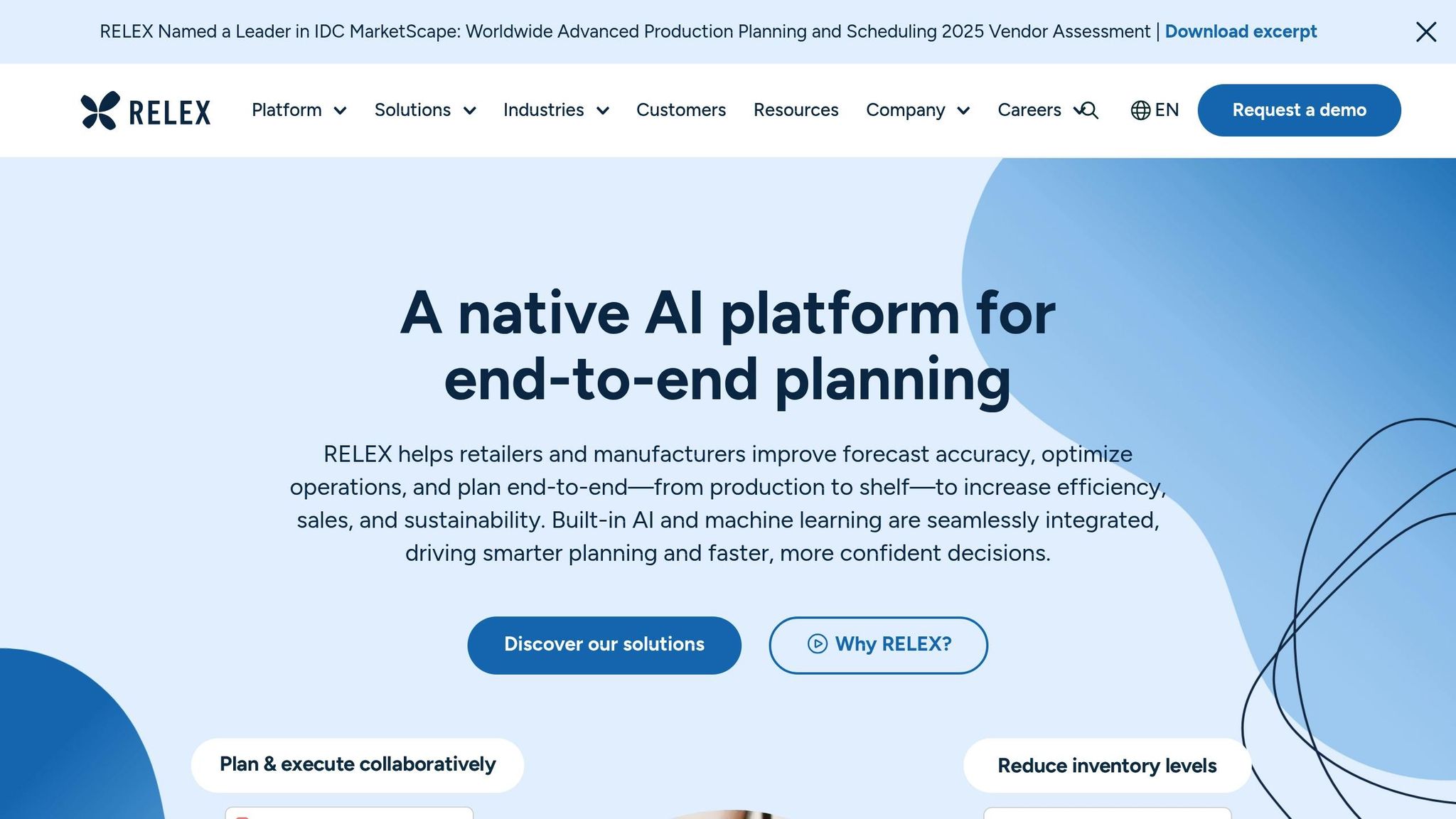
Relex Solutions steps in to tackle one of the trickiest challenges in supply chain management: keeping perishable inventory accurate and efficient in real time. Their platform is designed to streamline the process by combining real-time tracking, predictive analytics, and seamless integration with existing enterprise systems.
With Relex, businesses gain real-time visibility into their inventory. The platform leverages predictive analytics to anticipate demand by analyzing seasonal patterns and product lifecycles. This means businesses can make quick adjustments to stock levels, cutting down on waste and avoiding overstocking. By keeping a close eye on inventory and shelf life, Relex helps companies avoid common pitfalls like overordering and spoilage.
What makes Relex stand out is its ability to integrate smoothly with various enterprise platforms. This unification of inventory data across multiple channels ensures a more streamlined supply chain without disrupting current workflows.
The platform also addresses two major risks in perishable inventory: spoilage and stockouts. By fine-tuning ordering and replenishment cycles, Relex ensures businesses can manage items with short shelf lives more effectively. The result? Reduced waste, improved turnover, and better overall efficiency.
3. GMDH Streamline
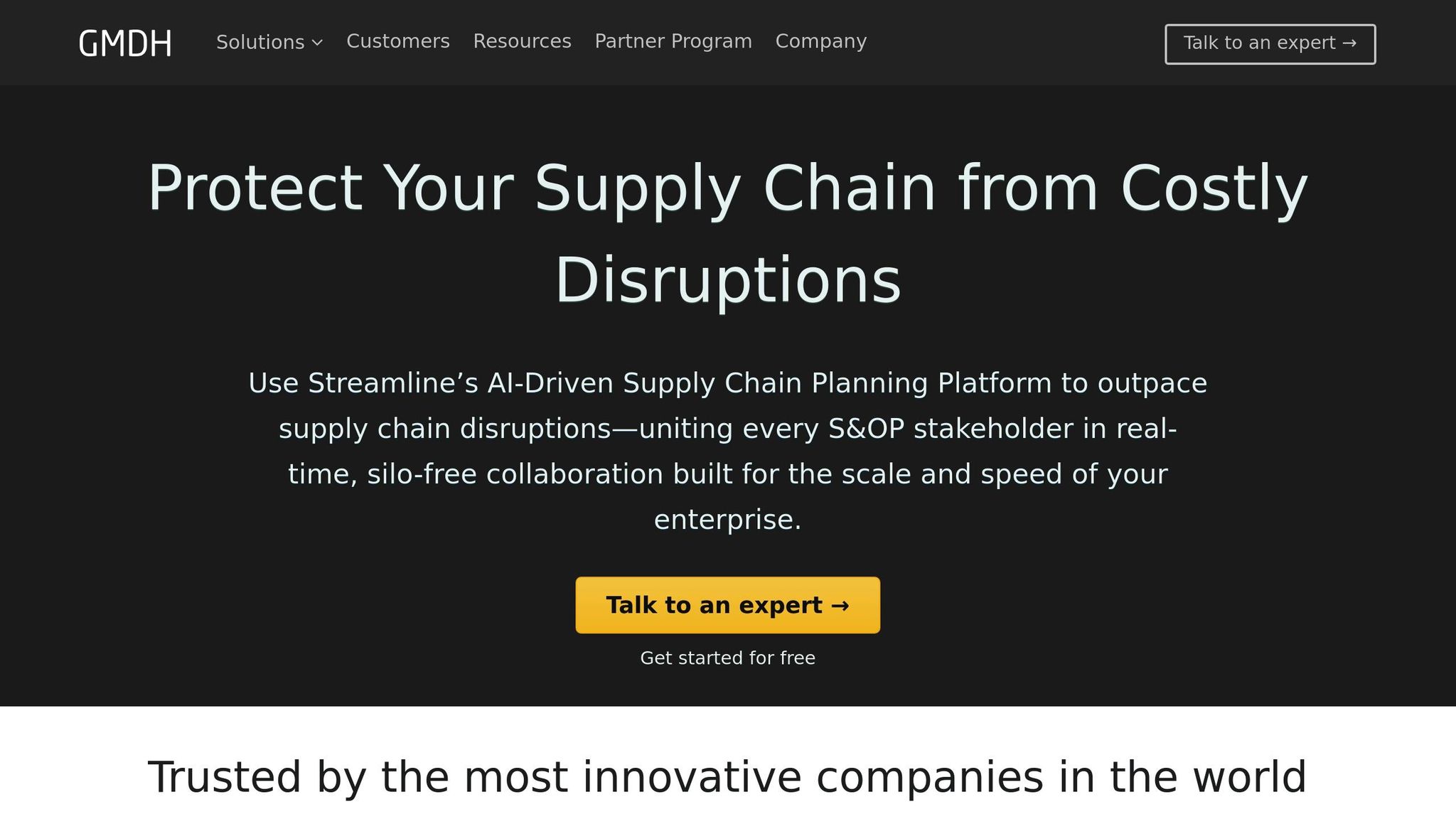
As AI continues to reshape inventory management, GMDH Streamline stands out by combining predictive analytics with smooth integrations to align stock levels with anticipated demand.
Predictive Analytics
At its core, GMDH Streamline relies on advanced forecasting algorithms to anticipate inventory requirements. This allows businesses to make quick, accurate decisions that keep operations running efficiently.
Integration Options
GMDH Streamline connects effortlessly with various systems through ODBC, custom APIs, and Excel. It also integrates with leading ERP platforms, including SAP, Oracle, Microsoft Dynamics, QuickBooks, and Odoo. This level of connectivity ensures businesses can synchronize their inventory systems seamlessly, reducing inefficiencies and waste.
Suitability for Perishable Inventory
By combining reliable forecasting with strong integration capabilities, GMDH Streamline provides actionable insights that help businesses manage perishable inventory more effectively. This approach not only ensures optimal stock levels but also minimizes the risk of spoilage and waste.
4. EazyStock
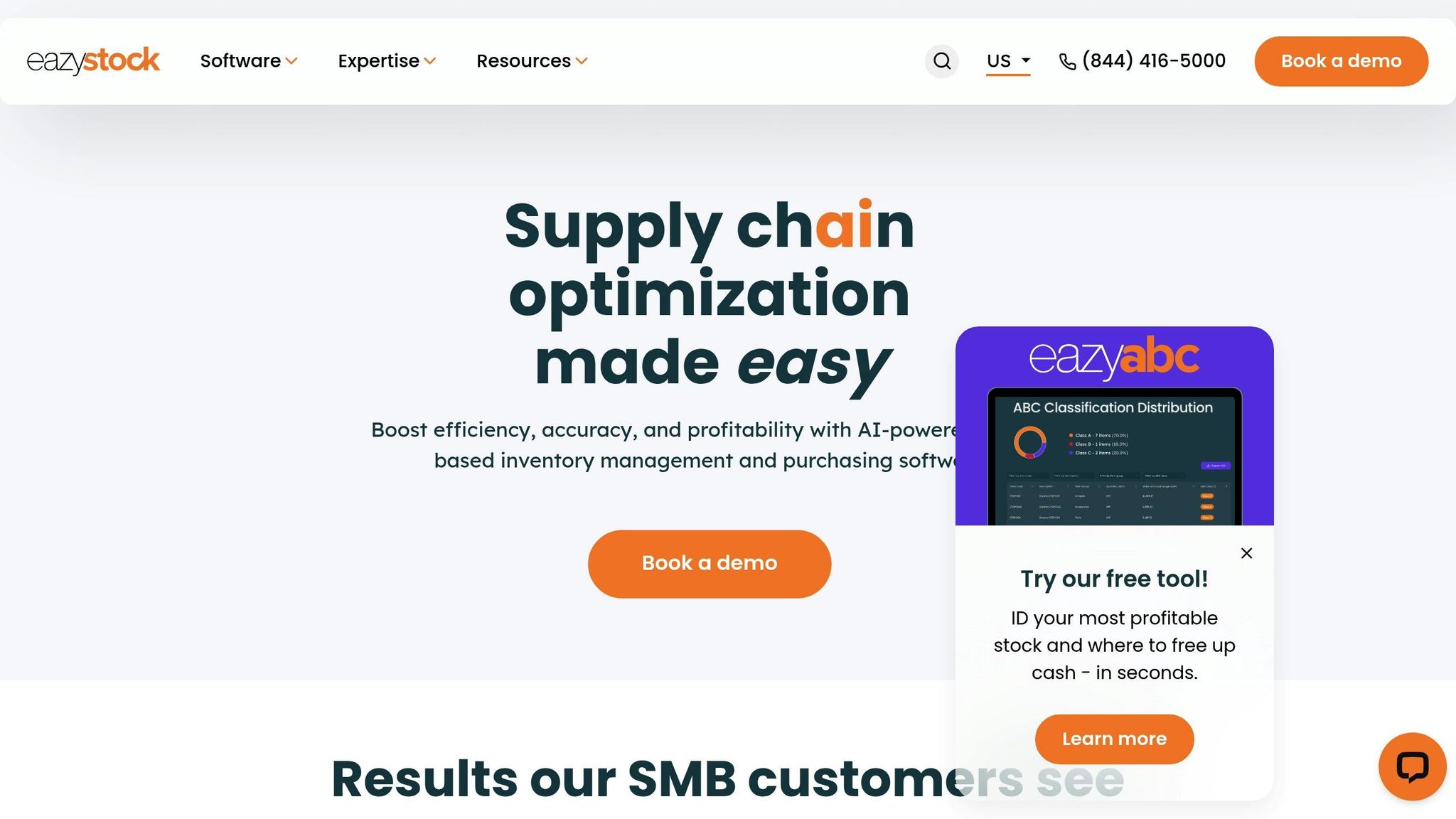
EazyStock leverages predictive analytics to help businesses manage perishable inventory more effectively. By analyzing historical sales data, seasonal trends, and market patterns, it forecasts demand with precision, reducing the risk of overstocking or waste. This allows businesses to stay ahead of demand fluctuations and make smarter inventory decisions. Plus, EazyStock easily integrates with existing systems, making inventory management even smoother.
sbb-itb-ef0082b
5. SkuNexus
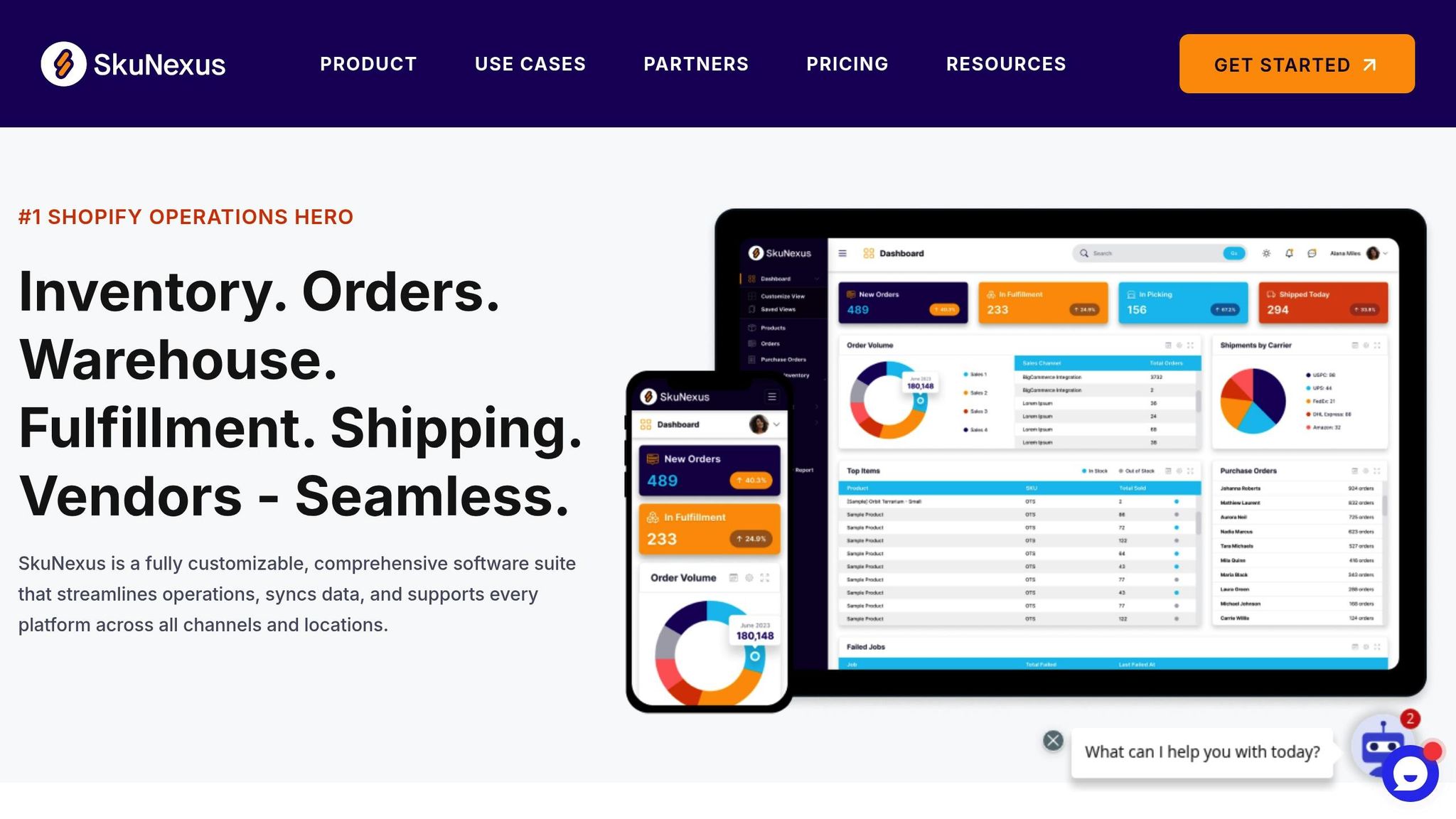
SkuNexus stands out as a platform designed to manage perishable goods with precision, offering advanced tracking and extensive integration options. Thanks to its headless architecture, businesses can tailor their inventory management processes while maintaining smooth operations across all channels.
Real-Time Tracking
With SkuNexus, businesses gain real-time visibility into inventory across multiple warehouses and locations. The platform automatically monitors stock levels, expiration dates, and product movements, ensuring up-to-date synchronization that helps avoid spoilage and stockouts.
These features have translated into measurable success for its users. Take Graeter's Ice Cream, for example. By integrating SkuNexus with their Magento eCommerce platform, the company automated 100% of their orders and achieved seamless multi-warehouse management through automated routing. This upgrade significantly reduced order errors and unscheduled stockouts, contributing to record-breaking holiday sales.
Integration Options
SkuNexus offers an impressive range of integrations, connecting with over 150 shipping carriers and various business systems. It works seamlessly with major eCommerce platforms like Shopify, BigCommerce, and Magento, as well as ERP systems such as QuickBooks, NetSuite, and SAP.
Carewell, an online marketplace, leveraged SkuNexus to enhance its branded dropshipping operations by integrating it with BigCommerce. This integration streamlined vendor communication and automated the dropshipping process, boosting order accuracy and eliminating inefficiencies. The results? Carewell experienced rapid growth, secured $30 million in venture capital funding, and earned a spot on Inc.'s 5000 Fastest-Growing Private Companies list.
SkuNexus not only excels at integrations but also optimizes the entire order lifecycle for perishable goods.
Suitability for Perishable Inventory
When it comes to managing perishable inventory, SkuNexus delivers comprehensive lifecycle management with automated routing. Its unified dashboard provides a clear view of every order's journey, making it easier to handle time-sensitive products and ensure proper oversight.
"Seamless integration with all major eCommerce platforms, automated routing, and a unified dashboard combine to provide a holistic view of every order's complete life cycle."
New Look Vision Group, Canada's largest eyewear retailer, adopted a custom omnichannel solution with SkuNexus integrated into their existing Magento platform. This setup automated their entire order management process, including picking, packing, shipping, and inventory management across multiple warehouses, enabling their rapid expansion.
The platform’s ability to create custom connectors ensures compatibility with even the most unique systems. Notably, 78% of BigCommerce merchants reported reduced operational overhead after implementing SkuNexus, highlighting its effectiveness in simplifying complex inventory processes. The following feature comparison will further illustrate its capabilities.
Feature Comparison Table
When selecting an AI tool for managing perishable inventory, it's crucial to compare how each platform performs across key features. Here's a breakdown of their capabilities:
| Feature | Netstock | Relex Solutions | GMDH Streamline | EazyStock | SkuNexus |
|---|---|---|---|---|---|
| Real-Time Tracking | Advanced demand sensing with multi-location visibility | Unified real-time data across all channels | Real-time inventory monitoring with automated alerts | Live inventory tracking with exception-based alerts | Multi-warehouse real-time visibility with automated synchronization |
| Predictive Analytics | AI-driven demand forecasting with seasonality detection | Machine learning algorithms for demand prediction | Statistical forecasting with trend analysis | Advanced forecasting with seasonal adjustments | Predictive routing and demand planning |
| Integration Options | Extensive ERP and business system integrations | Extensive retail and supply chain integrations | API-based connections to major business platforms | Seamless ERP integration with systems like SAP, Oracle, and NetSuite | Integration with multiple shipping carriers and major eCommerce platforms |
| Perishable-Specific Features | Expiration date tracking and shelf-life optimization | Temperature monitoring and freshness algorithms | FIFO/FEFO inventory rotation and spoilage prevention | Shelf-life management and waste reduction analytics | Automated routing for time-sensitive products |
| Best For | Mid to large enterprises with complex supply chains | Large retailers with omnichannel operations | Small to medium businesses seeking automation | Companies with diverse product portfolios | eCommerce businesses with multi-warehouse operations |
| Key Strength | Comprehensive demand planning across multiple scenarios | End-to-end supply chain optimization | User-friendly interface with quick implementation | Exceptional forecasting accuracy for varied product types | Flexible architecture with extensive customization |
| Potential Limitation | May require significant setup time for full optimization | Higher complexity for smaller operations | Limited advanced analytics compared to enterprise solutions | Primarily focused on forecasting rather than full lifecycle management | Requires technical expertise for advanced customizations |
This comparison makes it easier to see how each tool aligns with different business needs. For example:
- Netstock is a strong choice for businesses managing diverse product lines, thanks to its advanced demand planning capabilities. However, the setup process might take some time to fully optimize.
- Relex Solutions delivers powerful end-to-end supply chain optimization, making it ideal for large retailers, though its complexity may not suit smaller operations.
- GMDH Streamline combines ease of use with reliable automation, a great fit for growing businesses that need functionality without overwhelming complexity.
- EazyStock shines in forecasting accuracy, which is especially valuable for handling fluctuating demand.
- SkuNexus excels in managing multi-warehouse operations and automating synchronization, making it a go-to option for eCommerce businesses with intricate routing needs.
Smaller businesses might lean toward simpler tools like GMDH Streamline, while larger, fast-growing operations may require scalable solutions like Relex Solutions or SkuNexus. Each platform offers specialized features designed to enhance real-time management and reduce waste in perishable inventory handling.
Conclusion
Artificial intelligence is reshaping how businesses manage perishable inventory by tackling challenges like waste reduction, accurate forecasting, and streamlined operations. These systems are designed to adapt to ever-changing market conditions, creating workflows that respond in real time.
One of the standout benefits? AI-driven systems can cut spoilage by as much as 40%. Features like automated FEFO (First Expired, First Out) stock rotation and real-time alerts about expiring products help businesses save significant costs.
But the benefits don’t stop there. By leveraging machine learning to analyze historical data, seasonality, weather patterns, and market trends, AI improves forecasting accuracy. This precision can reduce inventory expenses by 10–15% and boost service levels by 15–20%, which is especially critical for perishable items with unpredictable demand.
AI tools also simplify complex processes. Automating tasks like replenishment, stock classification, and order recommendations minimizes delays and reduces the need for manual intervention. These systems often integrate seamlessly with ERP platforms and provide real-time alerts to handle supply chain disruptions swiftly.
A great example of AI’s potential comes from "RetailMax", a major retailer that adopted an AI-powered inventory solution. Using predictive analytics and automated replenishment, RetailMax achieved impressive results in just six months: 18% lower inventory costs, 25% better service levels, and 30% fewer stockouts. Their success highlights how AI can transform perishable inventory management.
When evaluating AI tools, consider how well they align with your specific needs - factors like integration, product complexity, and the level of customization required are key. Also, match the implementation timeline to your current capabilities. For instance, tools like GMDH Streamline offer quick deployment for immediate results, while more robust solutions might need extra planning.
For businesses dealing with perishable goods, the question isn’t if AI should be adopted but which solution will best reduce waste, enhance customer satisfaction, and scale operations effectively. The examples and data above make it clear: AI tools are a game-changer for managing perishable inventory.
FAQs
How can AI tools help reduce waste and improve forecasting for perishable inventory?
AI tools are transforming how businesses handle perishable inventory by using predictive analytics and real-time tracking to make smarter decisions. By analyzing historical sales data, seasonal patterns, and customer behavior, these tools help predict demand with greater precision. This allows businesses to stock just the right amount of inventory, reducing the risks of overstocking or running out of products.
On top of that, AI keeps a close eye on inventory in real time, flagging items that are close to their expiration date. By prioritizing the sale or use of these products, businesses can cut down on waste, improve stock rotation, and manage costs more effectively - essential for anyone working with perishable goods.
What should businesses look for in an AI tool to manage perishable inventory effectively?
When choosing an AI tool to handle perishable inventory, it’s essential to prioritize features like real-time tracking, predictive analytics, and the ability to accurately forecast demand. These functions play a key role in cutting down waste, keeping stock levels just right, and ensuring products are restocked in time.
It’s also worth checking if the tool is tailored to fit the needs of your industry, is straightforward to implement and use, and offers robust data security. Strong vendor support and easy integration with your current systems are equally important to maintain smooth operations and adhere to any necessary regulations.
How do AI tools integrate with existing systems, and what advantages do they offer for managing perishable inventory?
AI tools work seamlessly with platforms like supply chain management systems, warehouse software, and demand forecasting tools. These connections allow for real-time data sharing, streamlined coordination, and better tracking of perishable goods throughout their journey.
By integrating with these systems, businesses can predict demand with greater precision, cut down on waste, and fine-tune storage and transportation processes. This not only boosts operational efficiency but also ensures perishable products are handled properly, reducing spoilage and increasing profitability.
Related Posts
5 AI Tools to Reduce Customer Acquisition Cost in 2024
Discover the top 5 AI tools in 2024 to slash customer acquisition costs, enhance sales productivity, and drive business growth through automation and insights.
AI in Logistics: Cost vs. Benefits
Explore how AI tools in logistics streamline operations, reduce costs, and enhance customer service, while weighing the trade-offs of implementation.
How Predictive Analytics Improves Inventory Planning
Predictive analytics revolutionizes inventory planning for SMBs by optimizing stock levels, reducing costs, and enhancing customer satisfaction.
AI Order Fulfillment: Automation Guide 2024
Discover the benefits of AI order fulfillment automation in e-commerce. Learn how to implement AI successfully and revolutionize your business operations.
